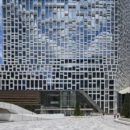July 7.2020

Architect Astrid Piber - UNStudio
MSc in Advanced Architectural Design, Columbia University, New York City, United States
Dipl.Ing. Technical University Vienna, Vienna, Austria. Joined UNStudio in 1998
If you had to choose three key words to describe the Hanwha HQ project, which ones would you pick?
User comfort, retrofit in place, performative building envelope.
In the Hanwha HQ project, what is the role of PV? How is it related to the building concept and architecture?
We can frame the role of photovoltaics on three different levels: the first one refers to the client, as Hanwha Group is the third largest photovoltaic producer in the world. When we were commissioned for this retrofit project, we were required to modernize and upgrade the building. Naturally, our suggestion was to install PV on the facades, because on high-rise buildings, the space available on the roof is limited. Moreover, integrating PV on the facades would enable us to include the modules in the architectural concept, while at the same time displaying Hanwha Group’s own products and thus connecting the project to the client’s brand.
What will you bring of the Hanwha HQ retrofit project to your upcoming works?
What we are seeing now, especially in Europe and in several big cities in Asia, is a new awareness and attitude towards retrofits. It is not always necessary to tear down a construction in order to build a new one. On the contrary, it is sometimes possible to keep what is still intact of the building and remodel the facades and the exterior, whilst integrating a sustainable strategy into this approach. Moreover, for many clients, a retrofit-in-place is actually a more affordable and reliable way to update buildings in need of renovations.
How important is the relationship between architecture and technology in projects of this scale?
We strongly believe in integrated solutions. Of course you could treat technology as a simple add-on, but then it would never be as effective as it can be. That is why we consider the integration of technology in the design approach essential for a project to succeed. The building envelope is not an isolated element, as it is connected to the structure of the building and to what is taking place inside. As a result, the two cannot be separated and consequently, you cannot separate technology from the design of the building.
Who supported UNStudio in the design and planning of the facade?
Our facade and sustainability consultant was ARUP Hong Kong, while the lighting consultant for the interior and for the facades was AG Licht, a company based in Cologne. Locally we worked with Gansam Architects from Seoul.
What was the most challenging aspect to manage?
Initially it was necessary to understand the old building in order to connect the existing structure to the new design. We wanted to upgrade the building and develop a unique design that contrasted with the previous appearance, as this was somewhat out-dated. Our idea was to bring an unconventional appearance to an administrative building, while creating a light and pleasant indoor environment. That was probably the biggest challenge; finding a way within the design to relate such a large building to the individuals that occupy it.
How did you define the characteristics of the “standard module” and of the “A-typical module”? Which inputs were taken into account? (size, glass type, shading effect on the window pane, etc.). Which tools have you used?
We divided the 3.60m grid of the existing structure into elements of 1.2m width. The height of the element and of the proportion of the sunshade panel varies depending on its function. The highest elements are located in the more public areas, while the ones with the bigger PV elements integrated into them are located on the south facade. We combined them in an ordinated way with the intention of creating a visually continuous façade field.
BIPV vs “conventional” building components:
a. Since the construct PV project UNStudio is working on new ideas with the aim to implement PV in the building envelope: do you see any difference in your way of work (design, plan, creation, etc.) when dealing with PV/BIPV and “conventional” cladding product (facade technology)?
We worked with a consortium on the PV Construct project with the aim of developing a module prototype. Our arch tech branch UNSense also just launched the product Solar Visuals that instead focuses more on the textures, the colours, the prints and how to create an active facade. The unique aspect of the Hanwha project however is that we could integrate conventional photovoltaics modules into the building envelope.
Does South Korea have special requirements in relation to the energy efficiency of buildings? (Building envelope/skin, technical installations, energy consumption, etc.)
Without getting into specifics, South Korea is very focused on reducing CO2 emissions. Since 2002, Korean projects with a GFA that exceeds 3000m2 have had to acquire a G-SEED certificate (Green Standard for Energy and Environmental Design), and the sustainable regulation from 2013 was followed in the case of the remodelling the Hanwha HQ. During the construction phase, the actual energy performance of the facade exceeded the required standards at the time.
Was there anything that particularly surprised you during the duration of the project? Do you have a favourite memory?
There were many surprises along the way, but what really struck me was the fact that we actually went for a bottom to top retrofitting: two floors at the time and while the building was still in use. We had never done something like that before and, even in South Korea, the Hanwha HQ building was only the second retrofit-in-place to have been carried out. Nevertheless, in the end, it worked really well.
How do you plan to integrate photovoltaics in your next projects? Do you favour a certain technology or type of application?
We are very excited about the new product called Solar Visuals, that our arch tech branch UNSense recently launched. It is a cladding material characterized by a high level of customizable aesthetics. The energy generating facade panels are tailor-designed in such a way that they can be integrated seamlessly into the façade surfaces of buildings, optimizing both its form and function. Compared to most current non-printed solar panels, these energy-generating facade modules hold an energy efficiency of up to 85%, with a capacity of 220 watts peak (Wp) per panel. At the moment we have several ongoing projects where we plan to use this product.


